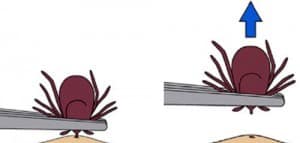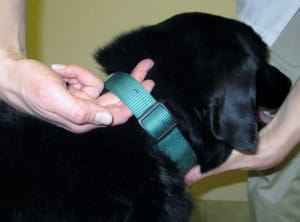Tick Life Cycle
Ticks are a parasite that can be found anywhere outside, however, they tend to frequent wooded or grassy areas the most. Brush, tall grasses, and leaf litter all make perfect hiding spots for ticks, where they can easily latch onto prey that brushes past their spot. Most ticks will choose a specific host, such as humans, deer, or dogs, however, some ticks will choose any host that walks by. A tick’s life stage can also change what hosts they seek out.
The tick life cycle can last three to four years. Ticks start as eggs, which are laid by an adult female tick after a blood meal. Unlike fleas, eggs are not laid on the host body, but instead in the environment. After several weeks to a few months, the eggs will then hatch into a larva. Summer is when most ticks hatch into larvae, however, they can also hatch during particularly warm periods of other months. After hatching, they’ll seek out their first blood meal, usually on smaller mammals that wander nearby.
After a feed, ticks then transition into the nymph stage. They will search out more blood meals through a method called “questing”, which involves raising the front arms to attach to a host that walks past. The nymph stage is also when many tick-borne diseases can be transmitted to the host via blood meals. After feeding as a nymph, ticks transition to their adult stage, and will attempt to feed again in the fall, or go dormant and feed again in spring. In between meals, ticks will mate and lay eggs, starting the cycle over.
What Do Ticks on Dogs Look Like?
Ticks can be tricky to spot sometimes. Here’s what to look for when checking for ticks, as well as symptoms your dog may have been bitten.
Appearance
A feeding tick can often be mistaken for a mole or even a nipple on your dog’s body. Ticks bury their head under the skin as they feed, leaving their back end sticking out. Often, this looks like a hard, round, black or brown spot. As the tick feeds, it will begin to engorge with blood, growing in size. Once the tick is done feeding, it detaches from the host body, leaving behind a small wound where it fed.
Symptoms
Your dog may attempt to scratch or bite at a tick as it is feeding, as the process can be itchy or irritating. After the tick has left, you may also notice a small wound, or a “bulls-eye” red mark surrounding the bite site. Tick-borne illnesses can present with several similar symptoms as well. These include fever, lethargy, loss of appetite, physical pain, or paralysis. In addition, some diseases may cause internal organ damage such as kidney disease. These problems can present with changes in thirst, urination, and bowel or eating habits.
Treatment and Prevention of Ticks on Dogs
Thankfully, there are many preventive medications available to help reduce or completely stop ticks from jumping on your dog. Here are some of the most common methods of treating ticks on dogs.
Over the Counter and Prescription Medications
Most over the counter and prescription flea medications are also formulated to prevent and treat ticks. These include the most popular brands such as Frontline and Advantage. Similar to their flea counterparts, these topical medications work by killing the tick when it hops on and attempts to feed before it has a chance to bite. Monthly oral medications, such as NexGard, also provide similar tick preventives in a monthly chewable.
Collar products, such as Seresto, work by repelling ticks before they hop onto the body and killing them once they do. Tick collars are very popular and effective for working dogs, such as hunting or tracking dogs that frequent areas where ticks live. Tick sprays are also beneficial for treating the environment. These sprays kill and repel ticks. Keeping frequented areas such as your backyard free of brush, large leaf piles, and tall grass can also reduce the tick population naturally.
Natural Remedies
Most natural tick prevention remedies are for treating the environment rather than your dog. It is always best to check if a product or remedy is safe for use on your dog’s skin before using it. Ticks are naturally repelled by citruses, such as lemon or orange scents. Essential oils such as peppermint, cedar, and citrus can also be sprayed in areas ticks frequent to help repel them. However, it is best to move any pets to well-ventilated areas if using them indoors. Several natural shampoos can also be used on your dog to repel ticks.

If you do spot a tick on your dog’s body, don’t panic. If tweezers are used, do not squeeze as this can release blood (and disease vectors) into your dog’s body. Tweezing can also accidentally detach the tick’s head, leaving it embedded under your dog’s skin, which may lead to an infection. Instead, try to get the tweezers as close to your dog’s skin as possible. Special tick-removal hooks can also be used and should be kept on hand if you frequent areas where ticks live.
Common Tick-Borne Illnesses
While this is not an exhaustive list, here are some of the most common tick-borne illnesses:
Lyme Disease
Lyme disease is one of the most well-known and common tick-borne illnesses. It is also transmissible to humans. The disease is caused by a bacteria, Borrelia burgdorferi, which is passed on through the saliva of ticks during a blood meal. While it was once considered serious only in the Northeast, Lyme disease is now widespread throughout all of North America. In dogs, symptoms include lameness, fever, changes to appetite or behavior, and kidney disease. You may also notice the familiar “bulls-eye” pattern that spreads out in a ring around the site of the bite.
If your dog has been bitten by a tick, or you suspect Lyme disease, it is best to seek veterinary care right away. Quick treatment can reduce symptoms and long-term problems. Lyme is diagnosed with a rapid SNAP blood test which provides results in 10-15 minutes. From there, your vet will prescribe a course of long-term antibiotics such as doxycycline or clindamycin. While most regular antibiotic treatment lasts 7-14 days, treatment for Lyme is given over 14-28 days as the bacteria can be persistent. Treating any secondary issues such as kidney disease may also be beneficial.
Tick Bite Anemia
While not a specific illness, tick bite anemia can occur when a dog is bitten by a large number of ticks at one time. This is most common in stray or outdoor dogs, however, it can happen to hunting dogs or those that frequent grassy or heavily-wooded areas without proper prevention. Every time a tick feeds, it takes a portion of blood as its meal. If enough ticks embed into a host body, they can eat a meal large enough to cause anemia.
Signs of anemia include lethargy,

reluctance to move, changes in appetite or bowel habits, pale gums, tongue, and nose, and rapid or labored breathing. Your vet can take a sample of your dog’s blood to check their packed-cell volume (PCV), also known as a hematocrit. This test determines the number of red blood cells circulating in the bloodstream. Too low of a number indicates anemia.
Treatment includes removing any ticks remaining on the body, as well as supportive care. IV fluids, nutritional supplements, and medications that promote the natural regeneration of red blood cells can all help reverse anemia. In severe cases, a blood transfusion may be needed to replace lost blood. If the tick bites caused any secondary illnesses, they should also be treated.
Tick Bite Paralysis
Caused by a reaction to the tick’s saliva, tick bite paralysis is a rare, but serious complication of ticks on dogs. This illness often occurs within days of a tick bite, starting as unilateral paresis or weakness of the limbs that may spread to full-body paralysis. As the illness progresses, it may begin to affect body systems such as the kidneys or lungs.
Symptoms include weakness, paralysis, or changes in gait on one or all limbs. Your dog may be reluctant to move, and may also not want to eat or drink. They may also have a fever, changes in urinary or bowel habits, or changes in breathing. It is best to seek veterinary care immediately. In most cases, treatment includes supportive care, removal of any ticks still on the body, and administration of a tick antiserum (TAS) to reduce symptoms. From there, recovery can take days to weeks, depending on severity.
Rocky Mountain Spotted Fever
Caused by the bacteria Rickettsia rickettsii, Rocky Mountain Spotted Fever (RMSF) was most prevalent in the Rocky Mountains. However, it has since spread across most of North America and can be carried by a number of different tick species. Arizona and the Southwest have one of the highest rates of this disease in dogs and humans. As with most tick-borne illnesses, symptoms include fever, lethargy, and weight loss. In addition, RMSF can also cause abnormal bleeding externally and internally.
A complete history, including any incidence of tick bites, as well as blood work to check for overall illnesses, clotting factors, and more can determine if RMSF is present. Your veterinarian may also suggest X-rays or ultrasound to check for internal organ damage. For specific confirmation of the disease, a sample of blood can also be sent out to a lab for an antibody titer.
As with most tick-borne illnesses, strong antibiotics over a course of 10-28 days is the best treatment. If your dog is also showing signs of secondary issues, hospitalization, supportive care, and additional medications are recomme

nded.
Other Bacterial Infections
Bacteria injected by a tick bite can cause a number of illnesses in dogs. These include Ehrlichiosis, Bartonella, Tularemia, and Anaplasmosis. The symptoms of each of these illnesses are very similar and can include fever, lethargy, swollen lymph nodes, changes in eating and drinking habits, or just general malaise. Some more specific symptoms can include lameness in the case of Bartonella, or abscesses with Tularemia.
Treatment for all of these conditions is similar and includes general blood work to check for secondary illnesses and anemia. SNAP tests can check for Lyme, Anaplasmosis, and Ehrlichiosis specifically. From there, treatment with a long course of antibiotics and secondary supportive care is best. Regular checkups and supportive care may also be needed in the case of long-term illness or kidney disease.
Other Organism Infections
Many microscopic organisms can also be passed on through the bite of a tick. These include Babesiosis and Hepatozoonosis. In addition to the typical symptoms of fever, lethargy, and loss of appetite, these organisms can cause additional signs of illness. These include vomiting, diarrhea, dehydration, and weakness or bleeding issues.
In addition to the usual antibiotics used for treating tick illnesses such as doxycycline and clindamycin, other treatments such as trimethoprim-sulfa, an antibiotic, and pyrimethamine, an anti-parasitic, may be used to kill the organism. Decoquinate, another anti-parasitic medication, may also be used in the treatment of long-term Hepatozoonosis infections.
The use of tick preventives as well as quick treatment of any ticks on your dog can help prevent them from getting ill. Be sure to take precautions when frequenting tick-heavy areas by using repelling collars, tick sprays, and even dog boots and clothing to protect the body. By knowing what to look for and how to treat it, you can keep your dog healthy and safe from ticks.





